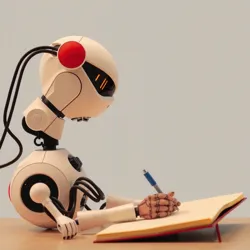Luminary Loom: Crafting Stories with Robotics
The Luminary Loom is an innovative project that merges the fields of robotics and literature to create new forms of storytelling. This initiative, part of the broader "Tapestry of Ink and Circuits," seeks to explore how robots can assist in crafting intricate literary pieces, thereby challenging traditional narratives and offering fresh perspectives on authorship. At the heart of this project is "Quillia," a robot specifically designed to mimic human handwriting, which has become a central figure in the literary world.
Overview
The Luminary Loom project was conceived as a response to the growing interest in the intersection of technology and creative expression. It aims to investigate the role of robots in literature and how they can contribute to or even transform the process of storytelling. By employing advanced robotics, the project seeks to expand the boundaries of what is possible in literature, both in terms of creation and interpretation.
Quillia: The Robotic Scribe

Quillia is a state-of-the-art robotic entity, designed to replicate the nuances of human handwriting. It is equipped with sophisticated algorithms that allow it to adapt to various writing styles and tones, making it a versatile tool for authors seeking to experiment with new forms of narrative. Quillia's ability to produce handwritten texts has sparked debates about the future of authorship and the potential for robots to become co-creators in the literary process.
Impact on the Literary World
The introduction of Quillia and similar technologies has prompted a reevaluation of the traditional roles of writer and machine. Some argue that robots like Quillia could democratize the writing process, making it accessible to those who might not have the skills or time to produce written works. Others are concerned about the implications for originality and creativity, questioning whether a machine can truly understand and convey human emotions.
The Luminary Loom has also influenced the development of robotic literature conferences, where writers and engineers gather to explore the potential of artificial intelligence in storytelling. These events have become platforms for discussing ethical considerations and the future of literature in a technologically advanced society.
Future Developments
Looking ahead, the Luminary Loom project aims to further integrate artificial intelligence into the literary process. Future iterations of Quillia may include features that allow for real-time collaboration with human authors, as well as the ability to generate entirely original works based on a variety of inputs. The project also seeks to explore the use of robots in other creative domains, such as robotic jewelry making, where machines craft intricate designs inspired by literary themes.
See Also
- Emerald Threads: A collection of jewelry inspired by constellations and dark matter.
- Voices of the Veldt: A study on regionalisms in Southern literature.
- Feminist Futurism: A conference exploring the intersection of feminism and robotics.
- Automaton Amethyst: A novel about a robotic jeweler crafting pieces with historical narratives.
References
- Whispering Pages: A project preserving regional idioms digitally.
- Jewels of the Cosmos: Gems that resonate with dark matter.
- Galactic Jewelry Symposium: Discussing the cultural significance of cosmic-inspired designs.